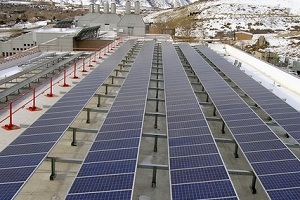Reviewing last week's solar energy news
 Last week was something akin to a hangover from Solar Power International. With all the events from the previous week, solar companies wanted some time to recoup. They didn’t get it, however. From international development, to unrest in the U.S., the solar industry steamed ahead.
Last week was something akin to a hangover from Solar Power International. With all the events from the previous week, solar companies wanted some time to recoup. They didn’t get it, however. From international development, to unrest in the U.S., the solar industry steamed ahead.
Perhaps the biggest recent development was German KfW Bankengruppe’s establishment of a $130 billion fund to support low-interest rate loans for solar in the country. The bank, owned by Germany, will make it easier for companies to gain access to capital for solar projects in Germany. It will help to ensure that the country remains among the biggest markets for solar and a heart of solar innovation.
Member manufacturers of the U.S. solar industry and Oregon’s Senatorial delegation spoke out against the Chinese solar industry’s practices, filing petitions alleging that the industry and China itself are engaging in unfair trades practices, dumping crystalline photovoltaic modules in the North American market at prices under market value. Oregon Senators Ron Wyden (D) and Jeff Merkley (D) spoke out against the practices, arguing that they were costing jobs in the U.S.
In two successive surprises, First Solar dismissed its CEO Robert Gillette, then announced its third-quarter 2011 results to slow down a stock free-fall. On Oct. 25, the company announced that Gillette was replaced by Chairman and Founder Mike Ahearn on an interim status. The move led to a 25 percent stock sell-off. The next morning First Solar released the company’s third-quarter 2011 earnings, which weren’t expected until Thursday, Nov. 3.
At this time, incentive programs are gearing up for the next year. For instance, Florida Power & Light Co. (FPL) reopened its solar rebate program for 2012 applications on Oct. 27. Under the rebate program, FPL makes $15.5 million available to homeowners and businesses to support photovoltaics and solar hot water systems. It’s proven to be extremely popular. The last two times the funds were open to applications, they were exhausted within a day.
In other states, like New Jersey and neighbor Pennsylvania, the industry might be imperiled by the end of solar incentive program. The Solar Alliance is pushing to increase the amount of solar utilities must buy through the state’s current solar renewable energy credit (SREC) system.
And Pennsylvania’s $100 million Sunshine Program, a one-time program, is running out of funds. The program, which supported new solar and the state’s SREC market was basically too successful. The program led to a quick build-out of solar in the state, reducing the price of SRECs from an anticipated $300 to $50 per kilowatt hour generated. As such, projects aren’t getting the return on their investments as expected, raising the cost of solar—at least in the near term.
Internationally focused nonprofits made a splash in the news last week. WE CARE Solar’s Solar Suitcase won one of 15 Tech Awards granted to new technologies that benefit humanity. It was one of five that received a $50,000 award. The device is a solar charger that can provide light for medical use at night to deliver babies. It can also charge batteries and cell phones, and power a laptop.
Solar Energy International—which trains people on the Solar Suitcase, among other things—announced that it was seeking funding to expand its education programs and support more scholarships. The organization helps bring solar training to disadvantaged communities in the U.S. and around the world.
Image courtesy of NREL.



